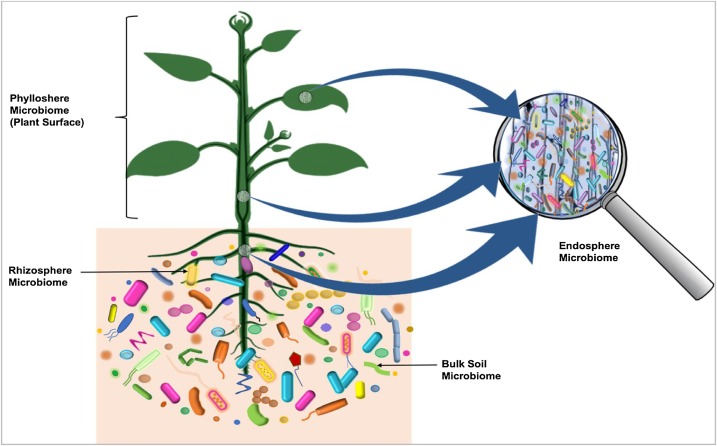Anwesha Sharma
Ph.D. Scholar, Department of Plant Pathology,
Assam Agricultural University, Jorhat, Assam
anweshakashyap97@gmail.com
Abstract
Microbes, the invisible architects of agricultural ecosystems, play a pivotal role in shaping plant health and productivity. This paper explores the intricate web of interactions between plants and microbes, focusing on their symbiotic partnerships, benefits, and challenges. Within the rhizosphere, microbial communities orchestrate a symphony of biochemical exchanges, facilitating nutrient uptake, water retention, and disease resistance. Beneficial microbes, such as mycorrhizal fungi and nitrogen-fixing bacteria, enhance soil fertility and plant growth through mutualistic relationships. However, alongside these allies lurk microbial pathogens, posing threats to crop health and yield. Integrated Pest Management strategies offer a multifaceted approach to disease management, harnessing the antagonistic interactions between beneficial microbes and pathogens. Looking ahead, advancements in microbiome research and biotechnology hold promise for optimizing plant-microbe interactions and fostering sustainable agricultural practices. By harnessing the power of microbes, we can cultivate resilient agricultural systems that thrive in a changing environment, ensuring food security for future generations.
Keywords: Agriculture, Microbes, Plant Health, Plant-Microbe Interactions
Introduction:
India is a land of agriculture, very rich in its biodiversity. When we talk about agriculture and its flora and fauna, one often overlooks yet indispensable player is the humble microflora and microfauna, which comprises the microbiome. These tiny organisms, invisible to the naked eye, wield immense power in shaping the health and productivity of our crops. From nurturing soil fertility to defending against pathogens, microbes are the unsung heroes of agricultural ecosystems. In this article, we delve into the fascinating world of plant-microbe interactions, exploring their diverse roles, benefits, and potential pitfalls.
In India, where agriculture is a cornerstone of the economy, the role of microbes in plant health is of paramount importance. According to the Ministry of Agriculture and Farmers’ Welfare, agriculture contributes significantly to India’s GDP, employing over half of the country’s workforce (Dutta et al., 2021). Soil degradation is a pressing concern in India, with issues such as soil erosion, nutrient depletion, and salinization posing challenges to agricultural productivity. Microbes play a crucial role in soil health restoration by promoting nutrient cycling, enhancing soil structure, and mitigating the effects of soil degradation. The adoption of microbial inoculants in Indian agriculture is steadily increasing. According to a report by the Indian Council of Agricultural Research (ICAR), microbial inoculants are being promoted as part of sustainable agriculture practices to improve soil fertility, increase crop yields, and reduce chemical inputs (Sharma et al., 2023). Indian research institutions like the Indian Agricultural Research Institute (IARI), National Institute of Plant Genome Research (NIPGR), and various agricultural universities are at the forefront of microbiome research and are actively engaged in studying the plant-microbe interactions and developing microbial-based solutions for sustainable agriculture.
Globally, agriculture faces challenges such as population growth, climate change, and resource depletion (Sharma et al., 2024). Microbial-based solutions offer promising avenues for addressing these challenges sustainably. The global market for microbial products in agriculture is experiencing significant growth. According to a report by Grand View Research, Inc., the market size for agricultural microbial products was valued at USD 3.3 billion in 2020 and is projected to reach USD 10.9 billion by 2028, with a compound annual growth rate (CAGR) of 15.4% from 2021 to 2028 (Sharma et al., 2024). Biofertilizers, including microbial inoculants, are gaining traction worldwide as alternatives to chemical fertilizers. According to the Food and Agriculture Organization (FAO) of the United Nations, biofertilizer production and use have been increasing globally, particularly in regions like Asia and Africa (de Faria et al., 2021). Numerous studies have demonstrated the positive impact of microbial inoculants on crop yields and soil health worldwide.
The Microbial Orchestra:
Within the rich soil beneath our feet lies a bustling microbial community, comprising bacteria, fungi, archaea, and other microscopic organisms. This diverse ensemble forms intricate networks of interactions with plant roots, collectively known as the rhizosphere. Here, microbes engage in a symphony of biochemical exchanges, aiding in nutrient uptake, water retention, and disease resistance. Mycorrhizal fungi, for instance, form symbiotic relationships with plant roots, extending their reach for nutrients while receiving carbon in return (Zhang et al., 2022). Similarly, nitrogen-fixing bacteria such as Rhizobium partner with leguminous plants, converting atmospheric nitrogen into a form accessible to the host plant.
The Benefits of Microbial Partnerships:
The collaboration between plants and microbes yields a myriad of benefits that underpin agricultural sustainability and productivity. One of the most significant advantages is enhanced nutrient availability. Certain microbial species solubilize essential nutrients, such as phosphorus and potassium, making them more accessible to plants. Additionally, microbes play a crucial role in soil structure and fertility, promoting aggregation and organic matter decomposition. This, in turn, improves water infiltration and retention, mitigating the effects of drought and erosion.
Furthermore, microbes act as natural biofertilizers and bio-stimulants augmenting plant growth and resilience (Daniel et al., 2022). Beneficial bacteria and fungi produce growth-promoting substances, such as auxins and cytokinins, which stimulate root development and nutrient assimilation. Moreover, microbial inoculants have shown promising results in enhancing crop yields and reducing the reliance on synthetic fertilizers and pesticides, thereby promoting environmentally friendly farming practices.
Navigating the Microbial Minefield:
While most microbes are beneficial, some can pose significant threats to plant health. Pathogenic microorganisms, such as certain fungi, bacteria, and nematodes, can wreak havoc on crops, causing diseases ranging from leaf spots to root rot. These pathogens often exploit vulnerabilities in plant defences leading to devastating losses in yield and quality. As such, effective disease management strategies are paramount to safeguarding agricultural productivity. Integrated Pest Management (IPM) approaches offer a holistic solution by combining cultural, biological, and chemical control methods to mitigate pest and disease pressures. Biological control harnesses the antagonistic interactions between beneficial microbes and pathogens to suppress disease outbreaks. For instance, biocontrol agents like Trichoderma and Bacillus spp. compete with pathogens for resources, produce antimicrobial compounds, and induce systemic resistance in plants, thereby reducing disease incidence.
Looking Ahead:
As we strive to meet the growing demands for food security and sustainability, harnessing the power of microbes holds immense promise for the future of agriculture. Advances in microbiome research, coupled with innovative biotechnological tools, offer new avenues for optimizing plant-microbe interactions and maximizing crop productivity. From precision microbiome engineering to tailored microbial inoculants, the possibilities are vast and transformative. Moreover, fostering interdisciplinary collaboration between agronomy, microbiology, and biotechnology will be crucial in unlocking the full potential of microbial solutions. By integrating cutting-edge science with traditional agronomic practices, we can cultivate resilient agricultural systems that thrive in the face of environmental challenges.
Conclusion:
Amidst escalating global challenges posed by climate change and increasing food security concerns, the integration of plant growth-promoting rhizobacteria (PGPRs) and biocontrol agents emerges as a compelling strategy for sustainable agriculture. Microbes offer tangible benefits in enhancing crop yields and resilience to abiotic stresses while minimizing environmental impact by reducing chemical inputs. The success of beneficial microbes hinges on their compatibility with host plants and their ability to function synergistically within microbial communities. As we move towards sustainable agriculture, let us not underestimate the power of these microscopic allies. Coupled with strategic biocontrol measures, these microbial solutions have the potential to revolutionize agricultural practices, fostering a greener, more resilient future for our planet through continued research, innovation and collaboration.
References:
Daniel, A.I.; Fadaka, A.O.; Gokul, A.; Bakare, O.O.; Aina, O.; Fisher, S.; Burt, A.F.; Mavumengwana, V.; Keyster, M. and Klein, A. (2022). Biofertilizer: the future of food security and food safety. Microorganisms, 10(6): 1220.
de Faria, M.R.; Costa, L.S.A.S.; Chiaramonte, J.B.; Bettiol, W. and Mendes, R. (2021). The rhizosphere microbiome: functions, dynamics, and role in plant protection. Tropical Plant Pathology, 46: 13-25.
Dutta, P.; Deb, L.; Gogoi, J.; Mahanta, M.; Kumari, A.; Yasin, A. and Sharma, A. (2021). “UmTricho” a liquid bioformulation of indigenous strain of Trichoderma harzianum effectively managed the tikka disease (Cercospora spp.) of groundnut, Arachis hypogea L. under the agroecological condition of Meghalaya. Biolofical forum-An International Journal, 13(2): 529-535.
Sharma, A.; Dutta, P.; Mahanta, M.; Kumari, A. and Yasin, A. (2023). Botanicals as a source of nanomaterial for pest and disease management. Plant Health Archives, 1(3): 96-101.
Sharma, A.; Kumar, S.; Singh, A.; Kumar, S.; Yadav, H.C.; Hazarika, S. and Hasan, R. (2024). Exploring the Role of Robotic Automation in Climate Vulnerability Mitigation: Towards Sustainable Horticulture. International Journal of Environment and Climate Change, 14(2): 6-13.
Zhang, L.; Zhou, J.; George, T.S.; Limpens, E. and Feng, G. (2022). Arbuscular mycorrhizal fungi conducting the hyphosphere bacterial orchestra. Trends in Plant Science, 27(4): 402-411.




